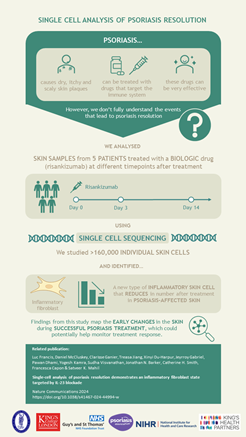15 March 2024
Understanding the Early Effects of Psoriasis Treatment - New Lay Summary Available
New research maps early skin changes in people receiving successful psoriasis treatment
Research published in Nature Communications provides a cell atlas of psoriasis skin during the first two weeks of biologic treatment. The full paper is available online here and you can read an overview of the study below.
People with severe psoriasis may take immunosuppressant treatments including biologics, which are injections that target specific parts of the immune system. These drugs can be very effective, but we don’t fully understand the sequence of events that lead to the resolution of psoriasis skin lesions.
Researchers from St John’s Institute of Dermatology, Guy's & St Thomas' Hospital and King's College London, studied the early effects of one biologic drug (risankizumab), which blocks the inflammatory protein IL-23. They took skin samples from five people with severe psoriasis, obtaining biopsies before these individuals started treatment and then again after three days and two weeks of taking the drug. They studied over 160,000 individual skin cells using a technique called single-cell RNA sequencing.
They found that a type of skin cell called fibroblasts, traditionally thought to be mainly structural, actually play a role in inflammation.
They discovered a new type of fibroblast that produces inflammatory proteins in psoriasis-affected skin. These inflammatory fibroblasts respond to proteins contributing to psoriasis onset and send inflammatory signals to other important skin cells called keratinocytes. The inflammatory fibroblasts decrease in number and reduce their activity after just two weeks of treatment.
This study maps the early changes in the skin during successful psoriasis treatment. It highlights the role of fibroblasts, especially a new inflammatory subtype, in the resolution of psoriasis.
The work was funded by the Psoriasis Association and the National Institute of Health and Care Research (NIHR). Key to the insights gained from this research was the generosity of the patients who participated in the study.
The full paper is available online (https://www.nature.com/articles/s41467-024-44994-w).
